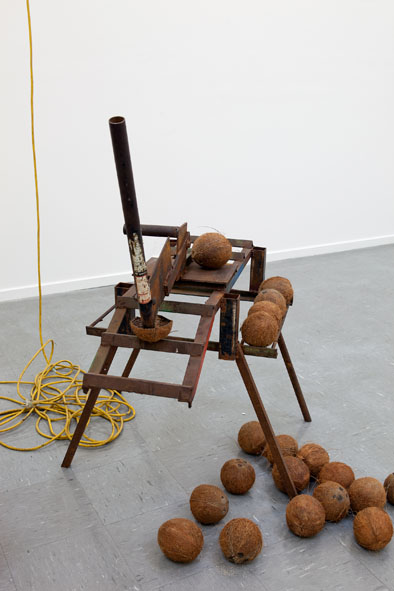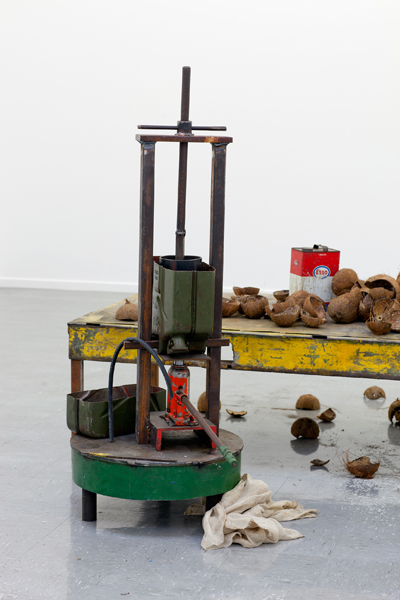Sutton Gallery is pleased to present Progress in action, a new large-scale project by Nicholas Mangan that draws upon the history of the 1989 civil war on the pacific island of Bougainville. In Progress in action, Mangan has created a functional coconut oil refinery in situ, which produces an energy source to power a video projection concerning Bougainville’s eco-revolution. The project continues his exploration of how natural resources are sculpted by forces of ideological and economical determination.
Rich in copper, Bougainville is home to the (now decommissioned) Panguna mine; one of the world’s largest opencut mines at the time of its closure in 1989. Opened by mining corporation Rio Tinto in 1964, with support from Papua New Guinea (PNG), the mine was actively opposed by the island’s indigenous peoples, who were aggrieved by issues of ownership and compensation for land damage. With no resolution in sight, the indigenous landowners of Bougainville formed the Bougainville Revolutionary Army (BRA) in 1988, and began interfering with the mining venture by cutting power supplies and blocking vehicle access. Such sabotage prompted the PNG Government to engage its military forces, effectively exiling Bougainville’s citizens on their island and denying them access to essential materials such as fuel, food and medicine. Imprisoned on their island, the BRA began resourcefully appropriating any available materials to protect themselves against PNG’s insurgent army, such as fashioning provisional weapons with equipment taken from the mine. Copra—the dried meat or kernel of the coconut which had traditionally been Bougainville’s main source of export income—now served as a way to overcome the marine blockade strategy used by the Papuan army, with the BRA manufacturing coconut bio-oil as fuel for their vehicles and diesel powered generators.
Paying homage to the BRA and its resourceful use of coconuts, Progress in action is an expansive project that will be exhibited across all three gallery spaces. Sutton’s main gallery will be transformed into a provisional coconut oil refinery, while Sutton Projects will house a specially modified generator, fueled by the coconut oil. This generator will in turn power a video projection of found footage that details the construction of the Panguna mine, as well as the events leading up to the Bougainville crisis. Through the presentation of this film, the very material at the core of this project is both physically and symbolically expressed, thereby creating an ingeniously cyclical relationship between the work’s subject matter and materiality.
Alert to both history and science, Mangan is a multi-disciplinary artist known for interrogating narratives embedded in a diverse range of objects. With a keen interest in the processes of forming meaning from objects, culture and natural phenomena, Mangan creates drawings, montages, sculptures and installations. His work addresses themes that include the ongoing impacts of colonialism, humanity’s fraught relationship with the natural environment, contemporary consumptive cultures and the complex dynamics of the global political economy.
Nicholas Mangan has exhibited extensively in Australia and internationally. His last major body of work, Some Kinds of Duration, was presented at Artspace, Sydney, in 2011 and Centre for Contemporary Photography, Melbourne, in 2012. Other solo exhibitions include: Let’s Talk about the Weather, Y3K, Melbourne, 2011; Nauru, notes from a cretaceous world, Sutton Gallery, Melbourne, 2010; Between a Rock and a Hard Place, Art Gallery of New South Wales, Sydney, 2009; and The Colony, Gertrude Contemporary Art Spaces, Melbourne, 2005. Selected group exhibitions include: Courtesy of the artist, CNEAI, Paris, 2013; Sinking Islands, Labor, Mexico City, 2012; Before & After Science, 2010 Adelaide Biennial of Australian Art, Art Gallery of South Australia; Lucky Number Seven, SITE International Biennial, SITE Santa Fe, 2008; The Shadow Cabinet, the second phase of Master Humphrey’s Clock, de Appel Arts Centre, Amsterdam; Adventures with Form in Space, The Fourth Balnaves Foundation Sculpture Project, Art Gallery of New South Wales, 2006; Uncanny Nature, Australian Centre for Contemporary Art, Melbourne, 2006; and Primavera, Museum of Contemporary Art, Sydney, 2004.
Artist’s profile







